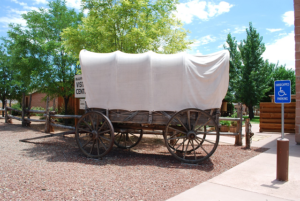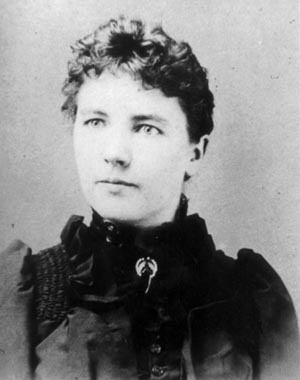Do You Know Laura?

Do you know Laura Ingalls Wilder? Her books were the first set of books that I bought with my own money when I was a child. Most of the copies that I have are falling apart from being read so much. She wrote about her travels through Wisconsin, Iowa, Indian territory in Nebraska, South Dakota (although it was the Dakota territory back then), and Missouri.
Her books brought to life the pioneer spirit of the people in this country. When I was a girl I never dreamed that I would actually get to see the land that she saw or the places where she lived. I have even lived in a house that was standing in some form when she drove by in her wagon.
As my children read and listen to her books, they can recognize and know places that she mentions. We have even been able to experience some of the things that Laura talks about in her books. Even though it has collapsed since then, we have seen where her sod house was in Plum Creek, Minnesota. We have been under the shade of the trees that they planted as seedlings in DeSmet. Pa went to Brookings to legalize his homestead claim. We have been in the surveyor’s house that they lived in during their first winter in DeSmet. My children have driven a covered wagon, made ropes, used a corn cob to make a doll, churned butter, and ground wheat with a coffee grinder.
</aBy Mark Goebel from Taos, New Mexico, USA (ib1222.JPG) [CC BY 2.0 (http://creativecommons.org/licenses/by/2.0)], via Wikimedia Commons>
I love the feeling that I get knowing that someone famous like Laura stood on the same piece of land where I am now standing. And it is even more exciting to me when I remember what they actually did on this land. Of all the historical figures I could mention, I feel the closest to Laura. I would love to be able to have my “eyes of history” superpower to see her and her family as they survived on the prairie.

Laura and her family traveled in their wagon from western Minnesota to DeSmet in the fall of 1879. Charles Ingalls had gotten a job as a book-keeper, company store keeper, and time-keeper for the Chicago and Northwestern railroad.The railroad was contracted out to DeSmet so they lived in a small shanty on Silver Lake. They lived in a camp with all of the railroad workers that were hired to lay the tracks.

Shortly before the winter of 1879, the camp was abandoned until spring. The Ingalls were living on the lake by themselves along with one or two other families.. They were given the use of the surveyor’s house for the winter. In February of 1880 Charles went to Brookings to file for a homestead claim to the south of DeSmet.
In the spring the railroad workers came back to DeSmet and to build up the town. Charles Ingalls bought two parcels of land in town to build his own business. He sold one rather quickly and the family moved into the other building until Charles could build a shanty on their homestead.
surveyor’s house, DeSmet
After Charles had finished building the sod shanty on their homestead they moved there to prevent claim jumpers from taking their claim. During the summer of 1880, Charles finished his building in town, farmed his land, and worked carpentry.
Winter came early that year, with a large blizzard in mid October that left 6-8 feet of snow on railroad cuts east of Brookings. Trains were not able to get through with supplies. After the blizzard there was a short time of nice weather during which the family moved back into town. However, one blizzard following another characterized that winter.

Laura describes in her books how they had very little food. They had a few potatoes and enough wheat for one small loaf of bread a day. There was nothing to burn to keep warm so they used slough grass tightly wound together to burn. It made enough heat to warm their kitchen, but it burned so fast that Charles and Laura took turns twisting the hay into sticks. The girls would spend their days around the kitchen oven. Caroline or the girls would spend each day grinding the wheat in their coffee grinder.
Spring came the first of April, but the trains could not get through until May. Unfortunately the train with food supplies was the last to come through. By the time the trains did come through, Laura wasn’t sure if they would make it through another day.
With the conveniences that we have today, it is hard to imagine what the settlers had to go through during this winter. We have warm houses, cars to use to stock up on supplies, grocery stores to get food, and heat by the turn of the thermostat. Not to mention meteorologists that give us a warning when a storm is coming.

Every time I listen to this story or we experience a little bit of Laura’s history, I want my children to understand the blessings of everything that we have. We have a warm house and blankets. We have enough food to eat. It is so easy to take what we have for granted. Just to survive, every member of Laura’s family had to work together. We can go into our freezer and get out a pound of butter, but Caroline and the girls had to milk the cow, skim the cream and churn the cream into butter. During this hard winter, there was very little hay to feed the cow so the cow was almost dry. No milk, no cream, and no butter.
Is it even possible for us to understand what that was like? I don’t know if I can understand. Sometimes I resent the amount of work that I need to do, but can you imagine having only one loaf of bread to share a day? Or to spend your entire day sitting by the fire because moving away is too cold? To spend freezing hours twisting hay so that you family will not freeze? I again realize that my blessings overflow. If Laura could see our lives today, what would she say?
We need to be grateful and thankful for the things that we have, even when it seems like we don’t have that much. Even living in a drafty old farmhouse like we do, we don’t have to worry about snow covering our beds or having enough fuel to burn to stay warm. We have a supply of food in our house that keeps our stomachs full. We can know about and prepare for a coming storm.
This is another example of why it is so important to learn our history. We can see how important it is to count our blessings and be thankful for everything that we have. What do you have that you can be thankful for?
[wpforms id=”111″]







